State of Online Video in 2022: Facts, Myths and Everything in Between
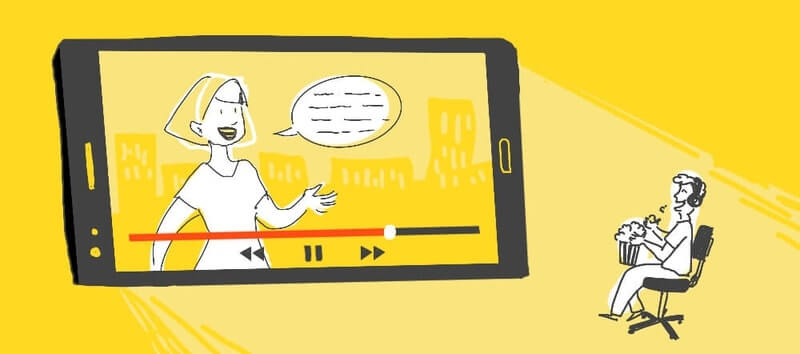

Much was talked about how video
will be the next big content format on the web - the new HTML.
Cisco's Annual Internet Report was considered the herald of an imminent gold rush by most companies
building their business around video (including yours truly) - in 2017. The report predicted that 82% of the
Internet traffic would be video by 2022.
A lot has happened over the past three years since that
forecast. Right now, it's fair to ask: is the Online Video trend worth its hype? Is it true that everyone is
adopting video for their business? And would you miss the boat if you don't get started with
videos?
Some of these questions are difficult to answer for two reasons:
1. It's hard to
differentiate between a boom and a bubble, especially in its nascent years marked by exuberance.
2. It's
impossible to draw a picture without access to data and insights about how videos are created, distributed, and
consumed today.
There is, however, an intriguing story behind this that's worth telling. We love a great
story. Which was all the more reason for us to take the time and effort to collate relevant data points to build a
story we think would reflect the state of Online Video as we enter 2022.
Online Video represents all video content formats streamed over the Internet to end-users
who watch content on smartphones, computers, digital smart TVs, or any other media device.
At a broad
level, you can look at Online Video from two perspectives:
1. Consumer
2. Business.
Online Video
for Consumer is video content designed primarily for entertainment or any other personal need. Those movies and
documentaries we find on Netflix? All of this can be categorized as Consumer Online
Video. This category also extends to videos watched on TikTok and other social media platforms or those
created and shared with your family. Online Video for Business are videos designed with the intent to achieve a
business goal. At some point, you've probably found yourself sitting through a pre-roll advertisement on YouTube.
Video ads are designed with a business objective - it could be brand awareness, getting leads for sales, or a
similar objective that aligns with a business goal.
It's important to understand the clear differentiation
within Online Video. Why?
Primarily to be able to understand and appreciate what's happening
differently within each domain. Since Consumer Online Video has distinct business models tied to it, like a
monthly subscription for entertainment (Netflix) or free content with advertisements (Instagram, YouTube), the
end-user of such video perceives it as a channel for entertainment or leisure. On the other hand, Business Online
Video is considered more persuasive by end-users with direct sales intent most of the time.
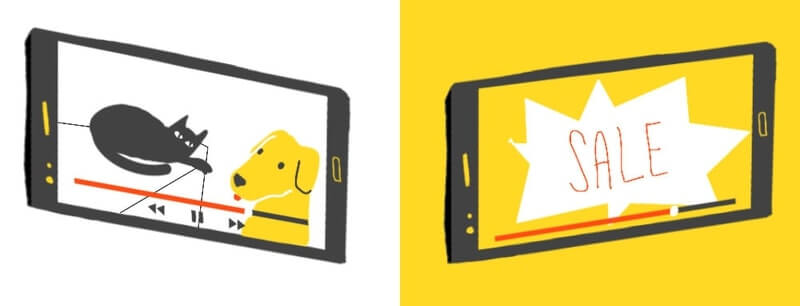
Consumer Online Video vs Business Online Video
Consumer Online Video as a domain has seen breakthrough disruption in the last decade. It
was reported three
years ago that 6 out of 10 internet users uploaded at least one video every month. Since then, this number has
only been rising with better internet adoption in the last few years. While that gives you a picture of how
smartphones have nudged consumers to create videos, the other side of the consumer story - that of online
entertainment- is equally compelling.
In a 2020 internet minute, more than 400000 hours of Netflix content are streamed by users
worldwide. Adding to that, YouTube has 2 billion
users (out of a total 4.66 billion internet users) who watch at least one video every month, and the number
grew by 200 million in the last 2 years. This will only spiral upward with the adoption of 5G technology standard
by broadband cellular networks.
Let's try to understand how the Business Online Video industry has been
doing. It appears that
65% of people believe brands don't produce videos worth-watching. Adding to that, with news being a category of
story that most users like to keep a tab on, it's surprising to see that only 2.5% of
average visit time was spent on video pages in a range of 30 online news sites. Creation of business videos
seem to have a lag as well. In a recent study 45% of media teams have paused or stopped a video campaign midway in 2020.
From these
stats, it's clear that videos created with a persuasive business intent are not the ones that are talked about
when annual reports shower accolades on Online Video. We will get into the details on this topic later as we try
to understand Online Video for Business in depth.
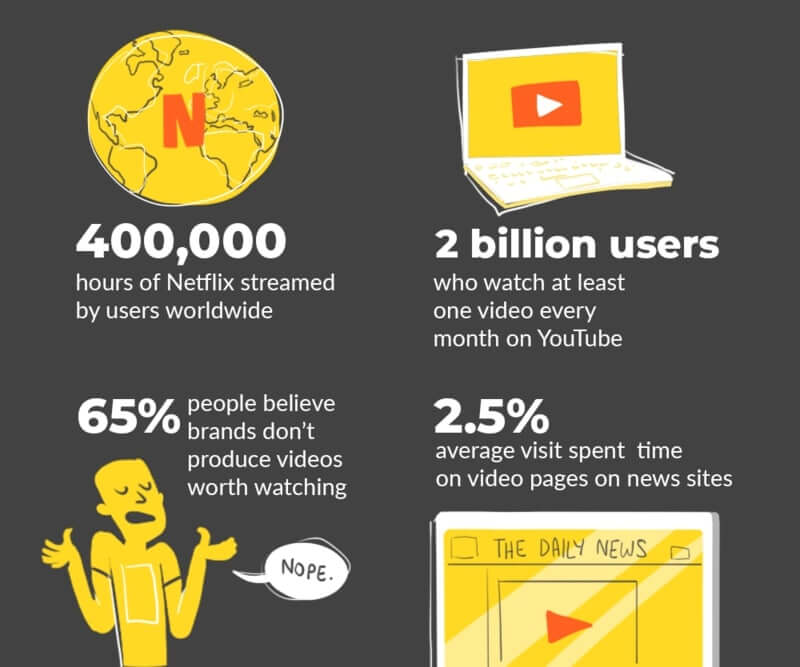
Comparing the findings of Consumer vs Business Online Video
Since David Ogilvy launched his agency's first successful advertisement, “The Guinness
Guide to Oysters,” for a hitherto unknown client called Guinness in 1951, the world of advertising has gone
through many waves of transformations.
The most significant change has been in
the format of content - which evolved
from print copy to digital video, all of it produced to get more sales or build more awareness for a brand.
One of the biggest wins of Online Video for Business has been in the advertising world,
which is now dominated by social media and search engines that offer the most valuable “real estate” for
advertising. Online Video drives a 250% clickthrough rate for many small e-commerce businesses running ads on
Facebook. Avenues like YouTube are understood to be cost-effective advertising platforms today for brand-building. Educational
videos also trump with 83% of people agreeing that a product/service explainer video aids a buying decision.
In contrast, 4 out of 10 people prefer watching educational videos over entertainment. This provides an
opportunity to create educational videos that can help their target audience. Another activity for brand-building
with video is its rising adoption on professional networks like LinkedIn. 54% of marketers have shared brand videos on
LinkedIn, and out of them, 78% believe it helped their business.
Now let's try to understand what's not working so well with Online Video for Business.
Video posts produced by news organizations received 30% less engaged time
than the average post. This contradicts the general notion of news like ‘videos tending to do better on social
media.' Adding to that, 91%
of people say that they decide if they're going to continue watching a video within the first 10 seconds.
Even if this validates the reducing attention span observed among users on the internet, it's also a
resounding testimonial for the risk that a business carries in creating videos with a business intent that goes
unwatched. While the jury is still out, this information could be interpreted as a need to create higher-quality
videos for social media instead of following cookie-cutter templated videos. We will look at how to make better
videos in the next section.
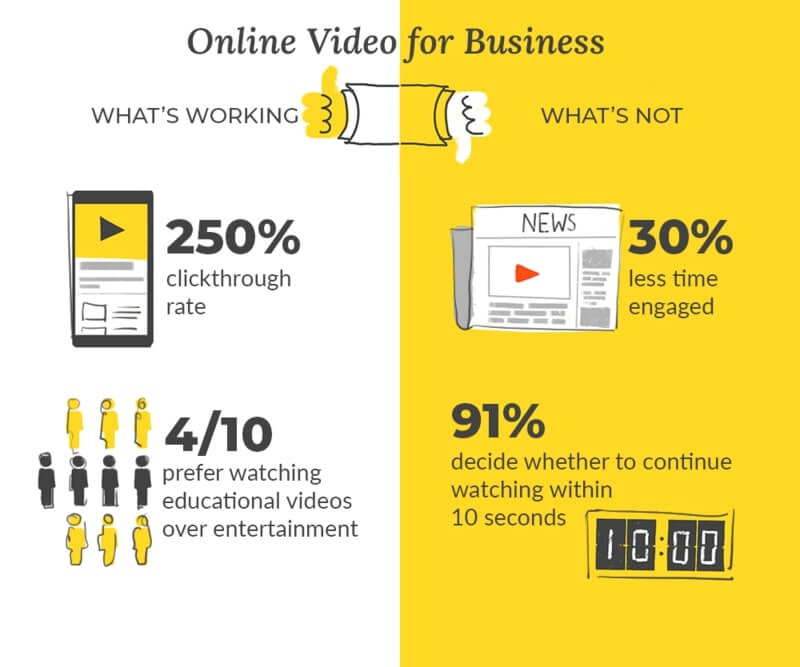
Here's what's working vs. what's not for online business video
When Toy Story was
released in 1995, it wasn't just the beginning of Pixar's dream run of blockbuster animated films. It also started
a new type of viable and economical video storytelling in the Business Online Video world - animated explainers
videos. They are videos that use computer animation technology to render characters and storylines.
Eventually, with the help of Adobe's Flash Animation technology and complex animation editors like After
Effects, it was soon possible for small-time video editors and studios to create moderate production quality
animated videos, which served the need for businesses who could get a promotional video for pricing that ranged
from $2500 to $25000 (as quoted by an animation studio 10 years
ago). But a lot has changed with Online Video in the last 10 years, and much of this primarily attributable to two
events:
1. Jawed, one of the co-founders of a startup called YouTube published a grainy low-resolution
video called “Me at the zoo” on April 23, 2005. The platform later made home video creation and shared a hip
thing to do and later paved the way to vlogging or video logging.
2. The launch of the iPhone on 29th
June 2007 and the subsequent wave of smartphones making it easy to record good quality videos. 13 years later,
it's possible to record an 8K resolution video using a smartphone today.
These two events initiated a
gradual shift in the kind of videos consumers ended up creating and sharing with others. We moved from a time when
a well-crafted animated video took 30 days to complete post-production, to present-day- creating videos with real
footage that takes zero seconds to publish. This also led to the shift in the type of videos we started using to
tell stories.
Real-life video footage now dominates animation - they are
quickly produced, high definition, and more authentic today.
Today 500 hours of videos are uploaded every minute on YouTube alone, with most of it being real footage based
productions.
Another critical transformation in the anatomy of the Business Online Video was the rise of
Text Videos as a
communication medium. This was propelled when Facebook decided to promote videos and nudged users to watch more
videos by auto-playing them with no sound on a scrolling news feed. Innovative publishers like BuzzFeed quickly
adapted. They now had to create videos with text to convey the story to viewers who were just watching videos (not
listening).
This new format became the most potent medium for commerce in the ensuing years since 2015.
How? It packaged the best of both worlds: videos are 60,000 times faster processed than other formats by our brains, and text provides a sense of control that makes it more likely for users to perform a buying decision. The
effectiveness of Text Videos has led to rising usage of embedded captions in most video platforms like Facebook,
Twitter, and LinkedIn.
Videos have now transformed their form to adapt to the platforms they are published
on and the devices they are consumed.The early years of the millennium saw widescreen videos (of aspect ratio
16:9) used on most of the Internet. Today we've expanded this with square videos (1:1) that work well on social
media feeds and vertical video (9:16 or 2:3) found to be effective for platforms, like IGTV and Tik Tok.
In a 2017
survey, 83% of marketers said they would increase their reliance on video as a strategy if there were no
obstacles like time, resources, and budget. This brings up another aspect of how Online Video evolved in the last
few years.
Video creators, today, explore ways to create videos quickly and easily. A few elements that
have really helped here is the availability of Stock Media, including photos, videos, and music,
that's widely used for designing video. Adding to that, the availability of Online Video Design
Tools like Typito that enables you to create videos with text animation and stock media helps more
businesses adopt Online Video.

The move from animated productions to real life footage
The one element of video that has always remained important
through the last 20 years is Story. Videos designed with a compelling story have done far
better than their counterparts irrespective of other elements constituting the video.
Storytelling will not only increase your brand affinity in your audience's eyes; it can also be up
to 22
times more memorable than facts. A brand's ability to tell stories reflect their ability to empathize and be
human- a strong reason why the top 10 most empathetic companies in the Global Empathy Index are amongst the most
profitable and fastest-growing in the world.

The elements that make a video tick today - text, stock media, format, and storytelling
Our reporting on the Design of Video won't be complete without evaluating what type of
videos are being created and published by businesses worldwide. We looked at 225,000 videos designed recently on
Typito and published by businesses ranging from freelancers to small marketing teams to agencies to large
corporations.
Among the insights we were able to draw, we understood two key points:
1. 53% of
these video projects had branded captions added on them - that is sub-titles that were designed to reflect the
brand identity in terms of colors, font style, and other characteristics.
2. On average, every video had 7
text animation overlays added on them, conforming with the popularity of the Text Video format we talked about.
These text overlays fall under the categories: Intros, Lower Thirds, Captions and Outros. All of these elements
help the creator stitch together a video story with text and media.
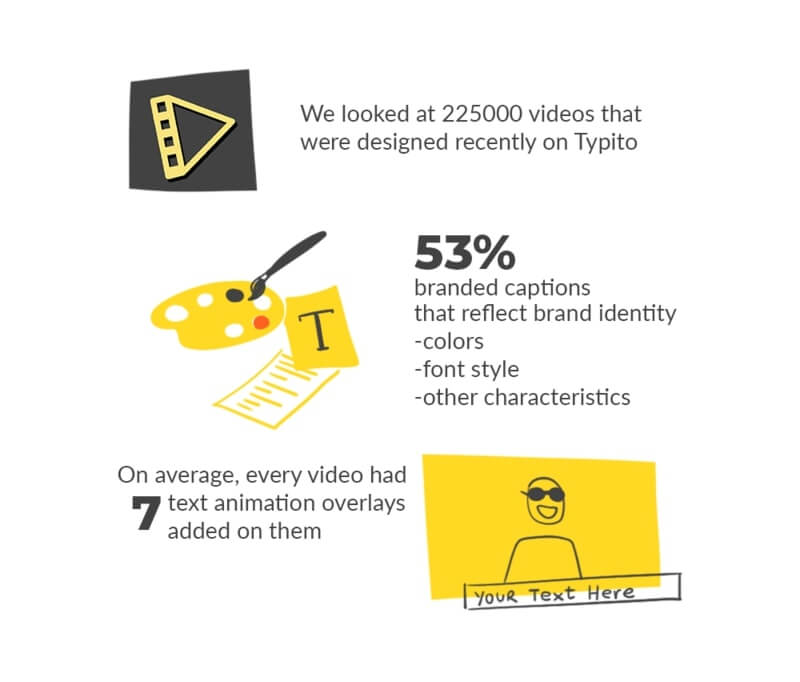
What we learned from analyzing over 200K Business Online Videos
These findings confirm our understanding of the anatomy of an Online Video for Business
today. Let's now try to look at an example of how these videos look like when designed with finesse and story.
If we had to pick a case study of how Online Video can achieve ambitious business
objectives, we needn't look further than the 2020 US Election. In the high stakes election that saw the ad
spends topping $1.5 billion, it's worth looking at how a specific organization innovated with videos and highly
regarded the media worldwide for their impact. We are talking about The Lincoln Project.
The pioneers of
The Lincoln Project have spent over 200 years electing Republicans and had decided to spark a nationwide movement
with a singular mission: to defeat the incumbent Republican U.S. President and his ideologies. Since its inception
on 17th December 2019, The Super PAC (Political Action Committee) has raised more than $65 million- a remarkable
achievement for a relatively new organization.
The Lincoln Project was able to perform incredibly well to
meet its business objectives of raising funds to run effective political campaigns. There's no way to undermine
the major role Online Video played in their game plan.
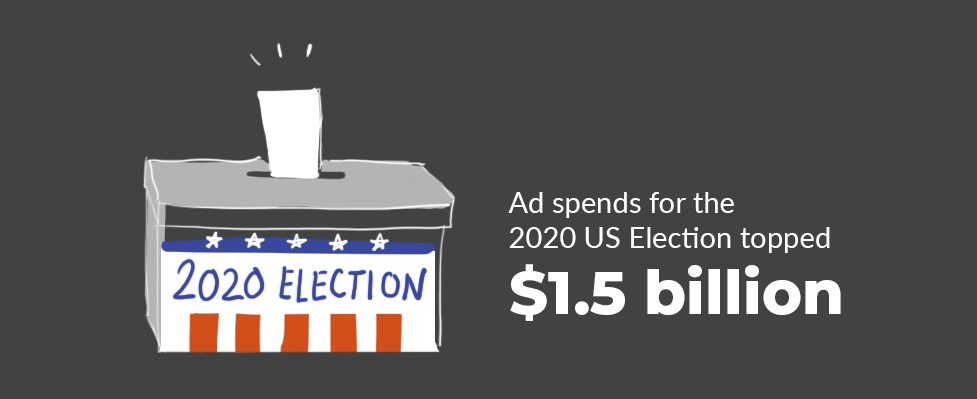
Amount of money spent for the US 2020 election campaign
The PAC published over 300 videos on YouTube and raked in more than 250 million video
views. Their performance on Twitter has also been phenomenal, clocking over 1 million views for almost all of
their short videos with tens of thousands of viewers engaging on each of them in the form of retweets, replies,
and likes.
Let's try to understand what video design was adopted by The Lincoln Project team becomes so
effective as a Super PAC by checking out one of the videos: Focus Group.
As you can see, the script carries the video from beginning to end. The use of text
animations amplifies this story phenomenally. This is also a brilliant example of the Connectionism Theory of
Information Transmission in Cognitive Sciences at play. In a nutshell, the theory illustrates how people retain
information about a topic better when provided with more cues to describe the topic.
The use of video
design elements like stock media and music makes it a video produced at a reasonable cost. With such reduced
production cost, it also makes it feasible for the editing team to design a video like this every other
day.
Apple's SuperBowl advertisement 1984 directed by Ridley Scott may have been once considered the face
of video advertising in the last century. Today, however, it's all about the ability to create short video ads
quickly and consistently for social media that are driven by powerful stories and scripts and stories just like
The Lincoln Project.
When a market matures, new categories get created around them, and they start picking
momentum. Facebook launched its Pages feature in 2007, which led to a new marketing category known as social
media marketing. As you can see in the Google Trends chart below, social media marketing has been on the rise
since then.
However, what's also evident from the chart is that video marketing has not picked up steam
as a function despite the hype we hear around about how video is disrupting content delivery format on the
internet.
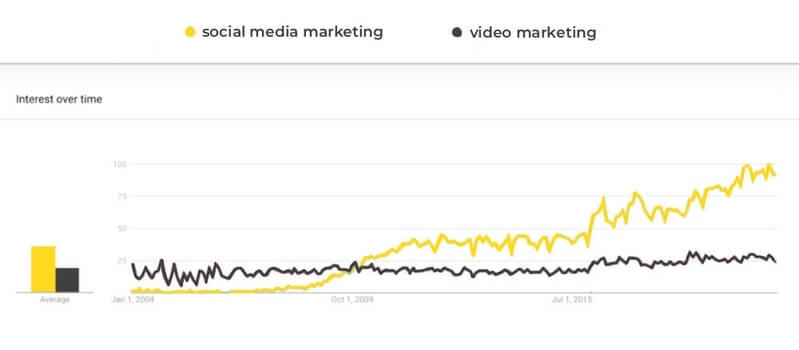
Google Trends shows the steady rise of social media marketing videos online
And that's where our need to differentiate between Consumer and Business Online Video
makes sense. While Consumer Video has had a meteoric rise in the past years, Business Video has not seen an
adoption anywhere close to that. This is precisely why you will find that very few businesses have videos on
their content calendar for marketing. It's because the format is still an experimental one that's not proven to
be an integral channel with reliable ROI.
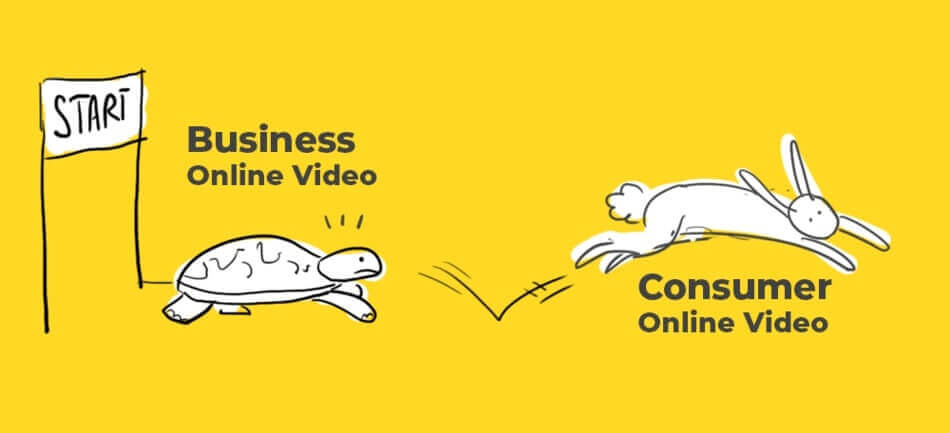
Business videos playing a game of catch up to consumer videos
But things have changed a lot in 2020, for the year was not a normal one. Let's
learn more about that.
Certain worldwide events lead to drastic behavioral changes, and the Covid-19 pandemic of
2020 has been one of them. The pandemic forced businesses worldwide to adapt to new ways of doing things.
One of the most prevalent tectonic changes has been the adoption of video
for various business functions - whether its client relations, team collaboration, or knowledge sharing. We have
suddenly become dependent on services that allow us to work and learn from
home, with video playing a central role in this transformation.
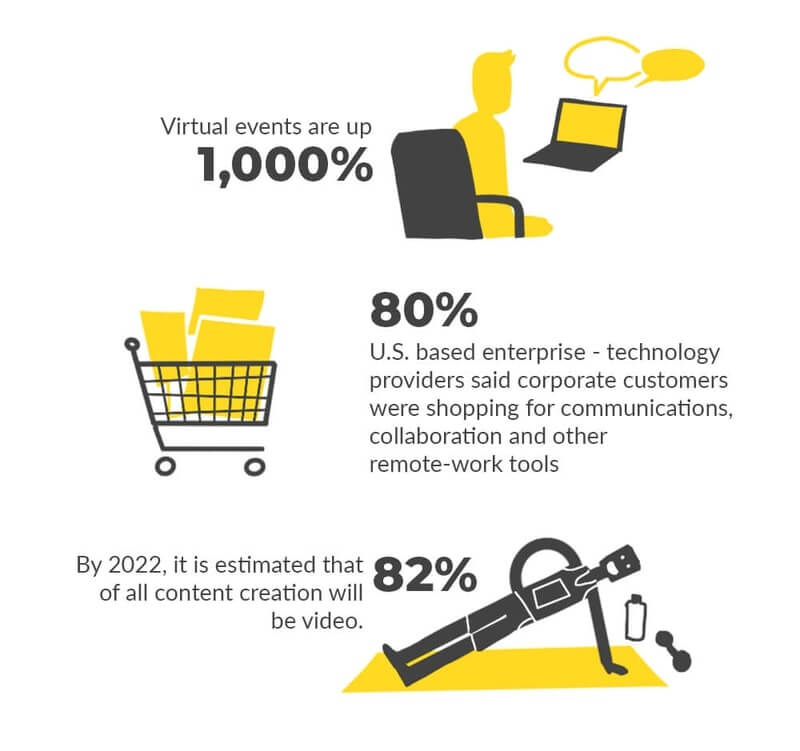
Impact of Covid-19 in the way businesses interact with video
Virtual events are up 1,000% since the inception of the Covid-19, and more than 80% of U.S. based enterprise - technology providers said corporate customers last month were shopping for communications, collaboration, and other remote-work tools, up from 76% in March 2020. Many hyperlocal small businesses have also changed their style of operations, the prime example being fitness studios going online, adopting Online Video as the means of teaching, and appearing poised to enter an online fitness boom. By 2022, it is estimated that 82% of all content creation will be video.
The changes in the way we interact with our surroundings via video will have long-lasting effects on the way we evolve as social animals. One of them would be our acquired ability to become comfortable with video as a medium for communication.

We believe this can be the turning point for Online Video for Business to finally
gather enough momentum to become a promising channel for businesses worldwide, especially with 5G and other
technology developments adding to the tailwind. Online Video for Business is not there yet in 2022, but the future
looks promising.







